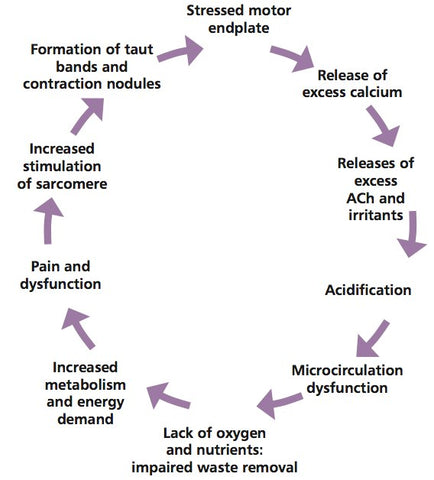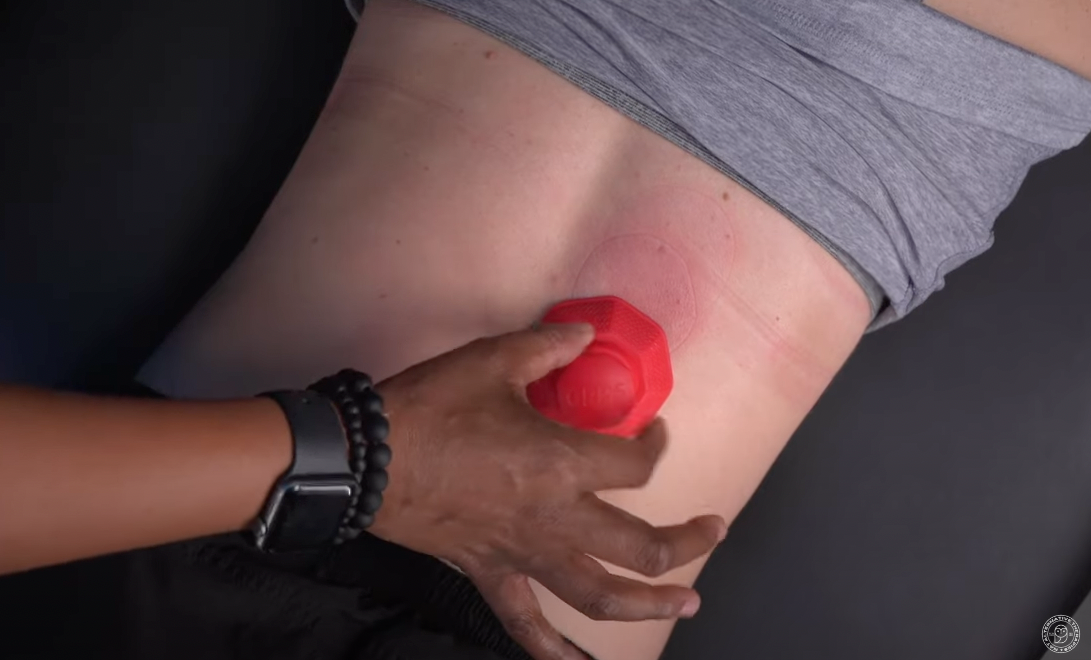Pathophysiology of Trigger Points
Trigger Points - An Overview of the Evidence
Understanding trigger points will change the way you think about pain management
Sadly, too many therapists remain out of the loop, when it comes to understanding trigger points. In the case of some, there is still a tremendous cynicism.
This is generally because these therapists have received a negatively biased education, and have somehow avoided the opportunities to learn and explore trigger point therapy first hand.
For anyone willing to take the time to piece it all together, there is plenty of freely available research to support trigger point therapy.
Mainstream acceptance of trigger point therapy has grown rapidly in recent years, most notably within the treatment rooms of elite sports and athletics.
We're committed to playing our part to push for the introduction of trigger point therapy as a standard teaching requirement for all manual therapists.
In todays trigger point blog we take a deeper look at where trigger points come from.

The Integrated Trigger Point Hypothesis (ITPH)
The ITPH is the current theory/working hypothesis. It explains most of the trigger point phenomena, and is based on the best electrodiagnostic and histopathological evidence to date.
First introduced by Travell and Simons in 1981 as the “energy crisis theory” (Simons et al. 1998), the ITPH has been expanded over the years by many others in the field.
Trigger points manifest in the region where sarcomeres and extrafusal motor endplates become overactive.
Microscopy has demonstrated that actin and myosin myofilaments (sitting within a taught band) stop sliding over one another and get stuck.
Reitinger et al. (1996) reported “pathological alterations” in mitochondria within these myofilaments, as well as an increase in the width of A bands and a decrease in the width of I bands.
The affected sarcomere(s) becomes permanently “switched on,” leading to a contraction and “wind-up.”
The swollen, contracted actin and myosin filaments may actually get stuck in the Z band because of the gel- like titin molecules ratcheting the fibers in place and preventing detachment (Dommerholt et al. 2006).

Cycle of misery: trigger point formation hypothesis – these individual links in the chain do not always occur in this order. (Sourced from: Starlanyl & Sharkey 2013.)
Active Trigger Points
Recent electrophysiological investigations have revealed that the electrical activity of “active trigger points” arises from dysfunctional extrafusal motor endplate zones rather than from (as previously thought) muscle spindles.
Electrical discharge frequencies of 10–1000 times normal have been demonstrated in the “endplate zone” in horses, rabbits, and humans (Simons et al. 2002, Dommerholt et al. 2006).
Histological investigation indicates abnormal calcium and ACh levels, and a shortage of ATP in the vicinity of the trigger point.
It is worth noting that Grinnel et al. (2003) demonstrated that stretching and/or hypertonicity of muscles causes a pulling of integrin protein peptides at the motor nerve terminal, triggering excessive ACh release without the need for calcium.
Other abnormal chemicals present in the milieu of “active” trigger points include (Shah et al. 2003):
Prostaglandins Substance P; Cytokines Bradykinin (BK); Hydrogen (H+); Calcitonin gene-related peptide (CGRP); Tumor necrosis factor (TNF-α); Interleukins IL-1 beta, IL-6, and IL-8; Serotonin; Norepinephrine.
These chemicals have many interactions and are part of various feedback loops. For instance, bradykinin is known to activate and sensitize muscle pain fibers (nociceptors).
This may help to explain some of the inflammatory hyperalgesia, tenderness, pain, and lowered pain thresholds seen in patients with chronic trigger points.
|
"Mainstream acceptance of trigger point therapy has grown rapidly in recent years, most notably within the treatment rooms of elite sports and athletics" |
Vicious Cycle of Energy Crisis
Sustained dysfunction and sarcomere contraction leads to local intracellular and extracellular chemical changes including:
• Localized ischemia/hypoxia
• Increased metabolic needs
• Increased energy (required to sustain contraction)
• Failed reuptake of calcium ions into the sarcoplasmic reticulum
• Localized inflammation (to facilitate repair)
• Compression or watershed effect on local vessels
• Energy crisis
• Production of inflammatory agents (which sensitize local autonomic and nociceptive fibers)
If this situation is allowed to continue over a significant period of time, the above changes lead to a vicious cycle. Calcium is unable to be taken into the actin and myosin myofilaments, leading to sarcomere “failure.”
Bengtsson et al. (1986), Hong (1996), and Simons et al. (1998) have all proposed variations of the energy crisis theory.
This theory suggests that the body attempts to resolve sarcomere and endplate failure (outlined above) by changing the blood supply to the sarcomere (vasodilation).
Inflammation
One further result of this anomalous situation is the migration of localized acute and chronic inflammatory cells.
Inflammation is a cascade: this cascade mechanism starts to occur around the dysfunctional sarcomere.
Inflammation brings with it sensitizing substances, such as bradykinin and substance P, a peptide present in nerve cells, which not only increases the contractions of gastrointestinal smooth muscle, but also causes vasodilation.
This has the effect of stimulating both local (small) pain fibers and local autonomic fibers, which in turn leads to increased ACh production and hence a vicious cycle.
Eventually, the brain sends a signal to the muscle in which the trigger point manifests to cause it to rest. This leads to hypertonia, weakness, shortening, and fibrosis (muscle stiffness) of the muscle, along with reflex inhibition of other muscle groups.
Under microscopy, these fibers have been described as “ragged red.” Treatment is thus aimed at interfering with and attenuating this vicious cycle.
A wide range of NAT online courses are available for therapists interested in taking their knowledge of trigger point therapy to the next level.
Links
Find a Trigger Point Professional in your area
More Articles About Trigger Points
Dry Needling for Trigger Points
Certify as a Trigger Point Therapist
About NAT Courses
As a manual therapist or exercise professional, there is only one way to expand your business - education!
Learning more skills increases the services that you offer and provides more opportunity for specialization.
Every NAT course is designed to build on what you already know, to empower you to treat more clients and grow your practice, with a minimal investment in time and money.
Help Desk
About Niel Asher Education
Niel Asher Education is a leading provider of distance learning and continued education courses.
Established in the United Kingdom in 1999, we provide course and distance learning material for therapists and other healthcare professionals in over 40 countries.
Our courses are accredited by over 90 professional associations and national accreditation institutions including the National Academy of Sports Medicine (NASM) and National Certification Board for Therapeutic Massage and Bodywork (NCBTMB). Full details of all international course accreditations can be found on our website.
Printed course materials and other products offered on our websites are despatched worldwide from our 3 locations in the UK (London), USA (Pennsylvania) and Australia (Melbourne).
More About Us
NAMTPT AWARD 2017
We are honored to have received the 2017 "Excellence in Education" Award from the National Association of Myofascial Trigger Point Therapists.
Since 1999 Niel Asher Education has won numerous awards for education and in particular for education and services provided in the field of trigger point therapy.
Read Full Article
Award Winning Instructors
Niel Asher Healthcare course instructors have won a host of prestigious awards including 2 lifetime achievement honorees - Stuart Hinds, Lifetime Achievement Honoree, AAMT, 2015, and Dr. Jonathan Kuttner, MD, Lifetime Achievement Honoree, NAMTPT, 2014.
Meet the Instructors
NAT Certification
If you are a qualified/licensed manual therapist or exercise/fitness professional you can expand your credentials with NAT certification.
In addition to national accreditation for continued education, each course that we offer includes "NAT Learning Credits". By taking and completing courses you can accumulate NAT credits to qualify for NAT certification.
There are currently 3 levels of NAT certification. Certifying NAT is a valuable way to show your clients that you take continued education seriously, and to promote your skills and qualifications.
About NAT Certification
Niel Asher Technique
Since 1999 the Niel Asher Technique for treating trigger points has been adopted by over 100,000 therapists worldwide, and has been applied to the treatment of a number of common musculoskeletal injuries.
The Niel Asher Technique for treating frozen shoulder was first introduced and published in 1997 and has been widely adopted by therapists and exercise professionals working within elite sports and athletics.
Read More
International Students
Most of our courses are available as either "Printed" or 'Download" editions. When you purchase a download edition, you receive immediate lifetime access to all course material. Course texts can be downloaded and printed if required.
When you purchase a "Printed" edition, you will also receive free access to the download edition.
We ship Worldwide from locations in the USA, UK, and Australia. Most items are despatched within 24 hours and shipping is FREE for all orders over US$50.
Shipping
This trigger point therapy blog is intended to be used for information purposes only and is not intended to be used for medical diagnosis or treatment or to substitute for a medical diagnosis and/or treatment rendered or prescribed by a physician or competent healthcare professional. This information is designed as educational material, but should not be taken as a recommendation for treatment of any particular person or patient. Always consult your physician if you think you need treatment or if you feel unwell.

Learn More for Less

Unlimited access to all CE courses for just $19.95/mo








